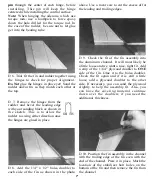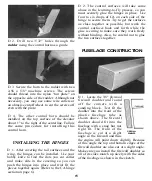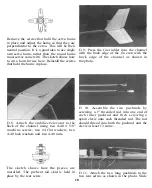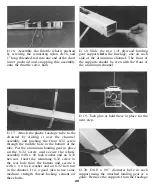
the outer pushrod tubes over the inner
pushrod until they are about 1/2" from the
servo end of the inner pushrod.
D 12. Press the balsa pushrod holder into
the channel about 6" in front of the fin and
secure the pushrods to it with the nylon tie
wrap. It is a good idea to seal the balsa
pushrod holder with a light coat of epoxy that
will also help hold it in place.
Note: The rudder pushrod goes to the left side
of the fin. The elevator pushrod goes to the
right side (as viewed from the back).
D D 13. Cut 2" off the threaded end of two of
the 12" long link rods. Use a pair of long nose
pliers to bend the "Z" in the unthreaded end
of the 2" pieces.
D 14. Install the link rods in the 2nd hole
from the outer end of each control horn. With
the control surfaces and the servo horns in
their neutral positions, cut the inner pushrod
so the link rod will thread into the inner
pushrod approximately 2/3 of the way.
Install the link rods into the inner pushrods
and adjust so that the control surfaces are at
neutral positions.
D 15. Wrap the receiver in at least 1/4" thick
foam rubber to protect it from vibration, hard
landings, etc. and use two rubber bands to
hold the foam rubber in place. Disconnect
the rudder and elevator pushrods from the
servos and slide the pushrods under the
rubber bands on the top of the receiver.
Position the receiver behind the servos and
reattach the clevises to the servo horns. The
switch can be servo taped to the fuselage
behind the receiver so it can be reached from
the back of the fuselage.
The receiver antenna should exit out the
back of the fuselage without encountering
any other wires if possible. Use a small
rubber band to hold the antenna on a T-pin
inserted in the top of the fin.
19






































